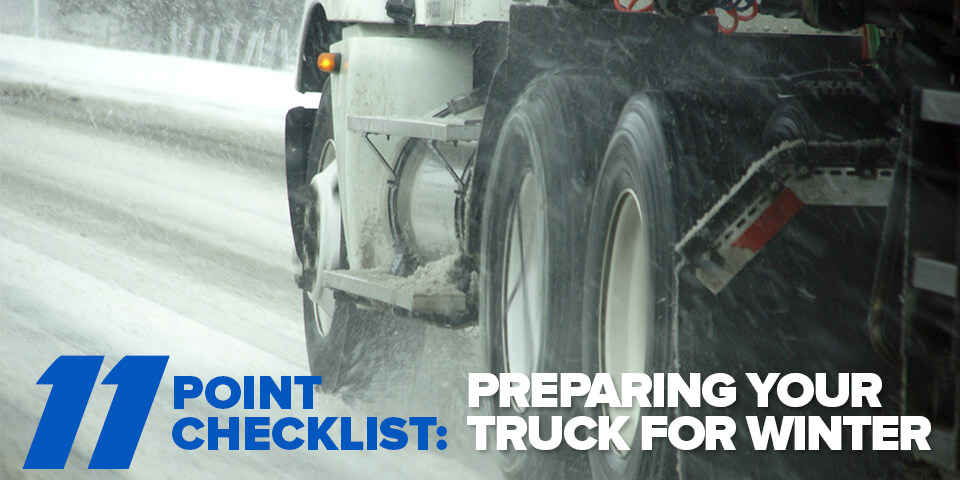In The News

11-Point Checklist for Preparing Your Truck for Winter
Is your truck ready for winter?
If not, the last thing you want to happen is to be stuck on the side of the road in bitterly cold conditions, especially for an issue that could have been avoided with proper planning.
So what can you do to prepare your truck to reduce the risk of downtime, improve truck safety, and be as productive—and profitable—as possible during the harsh winter months?
Veteran expediter Bob Caffee recently put together a great video where he starts underneath the hood and then walks around the truck, pointing out essential items to keep in mind to get your truck ready for winter.
Here’s an 11-point checklist, based on tips Bob shares in the video, to help you ensure you’re covering all your bases when “winterizing” your truck.
1. Replace belts.
Bob says that he likes to start each year with a new set of engine belts as a part of his winterizing routine. And if any of the old belts still have useable life left on them, he saves them to have on hand “in case we have a problem and break one.”
|
Prepare a Winter Emergency Kit. ● Extra blankets |
2. Check coolant.
You’re already checking coolant levels during your pre-trip inspections. But depending on the miles you have on the truck, you might consider having the coolant changed. And a good time to do that is before winter arrives at full force.
3. Inspect tire pressure sensors.
“We run a tire pressure monitoring system, so we always make sure our sensors are good and working properly,” says Bob.
4. Inspect brakes.
Bob says that he performs a thorough brake inspection in the fall to make sure “brake pads are thick enough to get us through the winter.”
5. Treat the windshield.
“This is the time of the year when I make sure I've treated the windshield with Rain-X or some type of aquaphobic coating on the glass,” says Bob.
6. Carry an extra set of windshield wipers.
“If you're running in ice and snow, and the wiper blades get built up with ice, you can just get out and swap [the wipers], throw the other ones under the defroster or on the floor to thaw out, and you're ready to go with another fresh set," says Bob.
7. Carry extra windshield washing fluid.
Make sure your windshield washer system is working properly and carry an extra gallon with you during the winter months, says Bob. “The law requires it to work. And I've had DOT officers ask me if I had an extra gallon. So I always carry an extra gallon of windshield washer fluid.”
Bob also recommends using winter blend washer fluid so that it will melt ice and snow whenever you're running in those conditions.
8. Check the wiring.
“On the chicken lights, if you have any, always check the wiring to make sure it's not hanging, or it's not going to gather up ice and snow," says Bob. "Same with your mid-turn signals. We have wiring back there that's going to get exposed to the rain spray and the ice and snow coming off. So make sure [that wiring] is tied up well."
9. Prep tire chains.
Bob says he uses automatic tire chains from Onspot, which cover the tires as-needed without having to stop the vehicle. The system engages and disengages by flipping a switch on the dashboard. This way, the driver doesn’t have to get out the truck in harsh weather conditions to manually install or remove the chains.
"I always take [the Onspot chains] off in the spring, so they're not just hanging underneath [the truck]. I then reinstall them [for the winter], making sure they're adjusted and do their swing properly," says Bob.
10. Rotate Tires.
“During the summer, we run trailer tires on our drive axle. So, in the fall, I change them back to a lug or a drive-type tire,” says Bob.
Why?
“We do that for two reasons,” says Bob. “We get better fuel economy when we run a trailer-type tread on the drive axle, and also, our drive tires last longer because they don't get run during the summer. So it's a bonus both ways for that.”
11. Retorque lug nuts.
“It's a good idea to have the lug nuts retorqued, even if you haven't gotten new tires lately, to ensure everything's in good condition there,” says Bob.
During the winter months, be extra vigilant with your daily pre-trip inspection, says Bob. “Double check and make sure everything is functioning properly, that all the lights work, the wires are tied up and secure so that ice and snow don’t gather up on them and pull them down."
